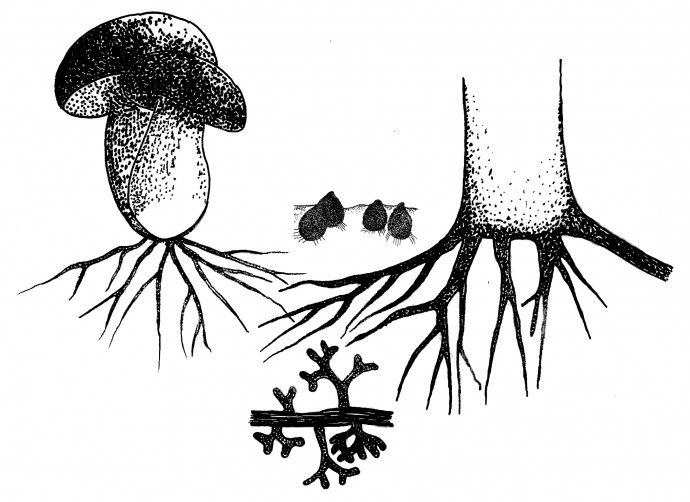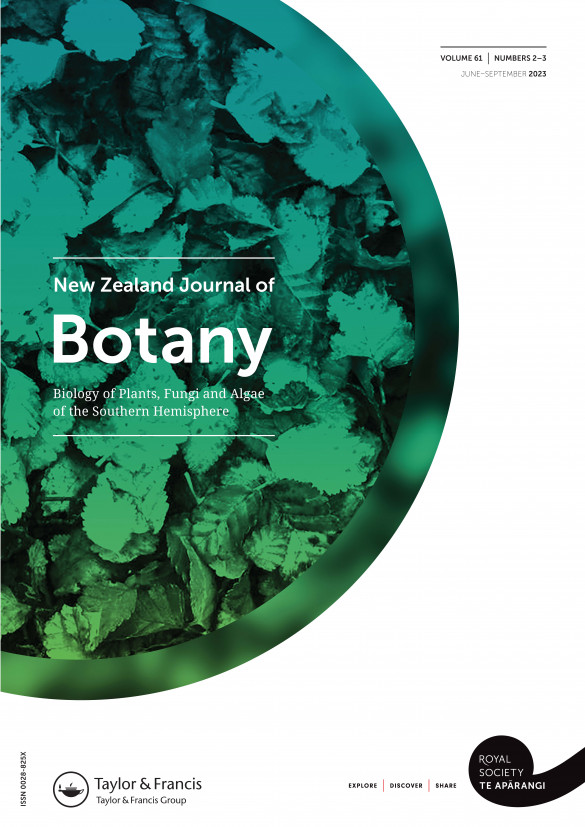News
Published 8 June 2023New Zealand Journal of Botany special issue call for papers: Recent advances in mycology

The New Zealand Journal of Botany (NZJB) is currently inviting paper submissions for a Special Issue titled "Recent Advances in Mycology." This exclusive issue seeks to highlight significant progress in the fields of fungal taxonomy, phylogeny, ecology, chemistry, and evolution.
Fungi are ubiquitous and play key roles in ecosystems as decomposers, endophytes, mutualists, and pathogens. Fungi generate a variety of chemical substances as secondary metabolites and volatile molecules. They also use hazardous organic compounds as their nutrition source. Therefore, the utilization of fungal resources is getting attention from the scientific community. Recent advances in mycology toward their industrial, medicinal, and ecological applications can be identified in several ways.
The tremendous diversity of fungi is still being studied and discovered, and DNA sequencing and other molecular methods have completely changed how these organisms are taxonomically classified. Advances in genomics have allowed scientists to sequence the genomes of various fungi, providing valuable insights into their biology, evolution, and potential applications. Understanding the diversity and ecological functions of fungi in various habitats has been aided by metagenomics, which involves studying the DNA recovered from environmental samples. Recent research has also shed light on the mechanisms of symbiotic interactions and their ecological significance. Conversely, fungal infections represent a serious risk to the environment, agriculture, and human health. Researchers have been studying the mechanisms of fungal pathogenesis and host-pathogen interactions with the aim of developing new antifungal therapies and strategies for disease management. The bioactive metabolites produced by fungi have the potential to be used in pharmaceuticals. Discovering novel antifungal, anticancer, and immunomodulatory chemicals from diverse fungi species has been a focus. As fungi are one of the remarkable sources of biotechnological potential, including the ability to produce enzymes, biofuels, and bio-based products, they are also being investigated. Researchers have been able to study fungi in unprecedented detail because of innovative techniques like imaging and microscopy. Our knowledge of fungal morphology, growth patterns, and cellular processes has improved through high-resolution microscopy, fluorescence imaging, and other advanced techniques.
In addition to the aforementioned advances, mycological evolutionary research has become more extensive. Comparative genomics and phylogenomic analysis reconstruct the evolutionary history and resolve phylogenetic relationships at various taxonomic levels of fungi and evolutionary patterns. Recent research has shown that horizontal gene transfer (HGT), which results in the acquisition of additional genes and functions, occurs in fungi. Understanding the role of HGT in fungal evolution can provide insights into their adaptability and evolutionary innovations. Studies on population genetics help in understanding speciation events, adaptive evolution, and the factors driving the diversification of fungi. Comparative transcriptomics involves comparing gene expression profiles across different fungal species or under different conditions. This approach helps in understanding how gene expression patterns have changed during fungal evolution and how they contribute to fungal adaptation, development, and ecological interactions.
The fossil record for fungi is sparse, but new finds of well-preserved fungal fossils have increased our understanding of their early development. Techniques such as micro-computed tomography (micro-CT) and high-resolution microscopy have been instrumental in examining fossilized fungi in exceptional detail. Molecular clock methods estimate the timing of evolutionary events by utilizing molecular data and assuming a constant rate of evolution. These approaches, combined with fossil data, have allowed researchers to estimate divergence times among different fungal lineages, providing a temporal framework for understanding fungal evolution.
Fungal studies have rapidly evolved and advanced. This special issue, intended for publication in the New Zealand Journal of Botany, will focus on advances in fungal taxonomy, phylogeny, ecology, chemistry and evolution.
Keywords
Fungal systematics, Fungal genetics, Fungal phylogeny, Fungal diversity, Fungal secondary metabolites, Fungal evolution
Submission Information
Your manuscript must be submitted via the NZJB portal on ScholarOne. You will need to select the relevant special issue title from the drop-down menu in the submission process. The due date for submissions is 3 Hakihea December 2023. Early submission is encouraged. A robust peer review process will be employed, and your manuscript will only be published if it successfully navigates the review process.
It is important that your manuscript is prepared according to the NZJB Instructions for Authors. Note that NZJB has a limit of 7,500 words (excluding references) for original research articles, but longer articles, including review articles may be accepted provided that the case for the greater length should be presented to the guest editors for approval prior to submission.
The complete reference style formatting can be found in this reference guide. An EndNote output style is also available to assist you.
There are no page charges or publication fees if authors publish under the traditional subscription-based model. In the meantime, Taylor & Francis partners with global institutions and funders to support researchers to publish gold open access in NZJB. These agreements often mean that individual authors can publish open access at no cost to themselves or benefit from discounted article publishing charges (APCs). Find out if you’re eligible.
Please direct queries to Prof. Samantha C. Karunarathna, Managing Guest Editor or to the Publishing Team of Royal Society Te Apārangi.
Guest Editors
Prof. Samantha C. Karunarathna
Center for Yunnan Plateau Biological Resources Protection and Utilization,
College of Biological Resource and Food Engineering, Qujing Normal University, Yunnan, China.
Adjunct Professor at National Institute of Fundamental Studies (NIFS), Sri Lanka.
Email: samanthakarunarathna@gmail.com
Interests: fungal taxonomy; fungal phylogeny; Basidiomycota; Ascomycota
Dr. Milan C. Samarakoon
Department of Entomology and Plant Pathology, Faculty of Agriculture, Chiang Mai University, Chiang Mai, Thailand.
Email: samare.ag.rjt@gmail.com
Interests: Plant pathology, disease management, fungal evolution, taxonomy and phylogeny
Dr. Indunil Chinthani Senanayake
Innovative Institute for Plant Health/Key Laboratory of Green Prevention and Control on Fruits and Vegetables in South China, Ministry of Agriculture and Rural Affairs, Zhongkai University of Agriculture and Engineering, Guangzhou, China
Email: indunilchinthani@gmail.com
Interests: Ascomycota, fungal taxonomy; fungal phylogeny; fungal phytopathogens
About the Journal
The New Zealand Journal of Botany is an international journal aiming to disseminate peer-reviewed scientific research in all areas of plant science. We welcome submissions relevant to all aspects of botany, mycology, and phycology of New Zealand and the southern hemisphere. Papers concerning general botanical principles and other species of the world likely to be of interest to a wide audience of plant scientists are also encouraged.
The journal’s subject matter encompasses biosystematics and biogeography, ecology, physiology, biochemistry, genetics, reproductive biology, structure and development, plant-animal interactions, forest ecology, taxonomy, ethnobotany, palaeobotany, bryology, lichenology, mycology, plant pathology, and phycology.

